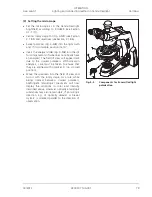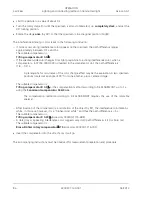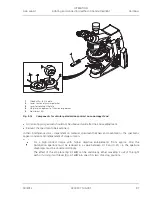
OPERATION
Axio Lab.A1
Lighting and contrasting method in transmitted light
Carl Zeiss
04/2013 430037-7144-001
83
(4) Conclusions
The grayish-white color appearing first in the
bright position in the above example (Fig. 4-7/
1
)
corresponds to a path difference of 150
nm
according to the Michel-Lévy color chart (Fig. 4-8).
When the compensator
O
is brought into the light
path, the non-birefringent "surroundings" of the
synthetic fiber appear in a dark red color, which
corresponds to the path difference of the
compensator of 550 nm (1st order interference
color for the path difference of 550
nm
corresponds to 1
O
).
If the direction of oscillation (n
J
or n
J
'
) of the
birefringent specimen to be examined is parallel to
the principal direction of oscillation (n
J
) of the
compensator
O
, i.e. in NE-SW direction, the path
difference of the specimen (e.g. grayish-white:
150
nm) and the path difference of the
compensator
O
(red: 550 nm). This results in a
color change of the specimen from grayish white
to greenish-blue (resulting path difference =
700 nm).
If the direction of oscillation of the specimen to be examined is perpendicular to the principal direction of
oscillation of the compensator
O
, i.e. in NW-SE direction, the path difference of the compensator
O
(e.g.
grayish-white: 150 nm) is subtracted from the path difference of the compensator (red: 550 nm). In this
case, the interference color of the specimen visibly changes from grayish-white to orange (resulting path
difference = 400 nm).
Color charts according to Michel-Lévy are available under Cat. No. 42-312.
4.1.4.4
Measuring path differences
The measurement compensators are required for exact measurement of path differences. These return,
i.e. compensate, the path difference created by the specimen to zero (black of the first order).
Whereas in the above-described methods the addition or subtraction position was of interest,
solely
the
subtraction position is of interest in the measurement.
Path differences in the specimen can assume very small values (1/50
O
or 10 nm) and very great values
(more than 10
O
or approx. 5500 nm and more) and with that determine the compensator appropriate
for the measurement.
The suitable compensator is determined as follows:
x
Set the microscope as for the transmitted light brightfield (see Section 4.1.1), taking care to ensure the
correct interpupillary distance in the binocular tube (see Section 3.5.5).
x
Accurately position the specimen to be examined on the center of the crosshairs.
Fig. 4-8
Schematic diagram of the color
charts according to Michel-Lévy
















































